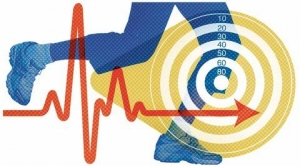 Do you want to get the most out of those 35 minutes on the treadmill, or any kind of cardio exercise? You maximize the benefits of cardiovascular activity when you exercise in the zone of your target heart rate(THR). In general terms, your THR is 60-80% of your maximum heart rate. The Karvonen Method of calculating THR is one of the most effective methods to determine target heart rate because it takes into account resting heart rate. Here’s how to find your THR.
Do you want to get the most out of those 35 minutes on the treadmill, or any kind of cardio exercise? You maximize the benefits of cardiovascular activity when you exercise in the zone of your target heart rate(THR). In general terms, your THR is 60-80% of your maximum heart rate. The Karvonen Method of calculating THR is one of the most effective methods to determine target heart rate because it takes into account resting heart rate. Here’s how to find your THR.
How to take your pulse
- Place the tips of your index, second and third fingers on the palm side of your other wrist below the base of the thumb. Or, place the tips of your index and second fingers on your lower neck on either side of your windpipe.
- Press lightly with your fingers until you feel the blood pulsing beneath your fingers. You may need to move your fingers around slightly up or down until you feel the pulsing.
- Use a watch with a second hand, or look at a clock with a second hand.
- Count the beats you feel for 10 seconds. Multiply this number by six to get your heart rate (pulse) per minute
 1) Find your resting heart rate as soon as you wake up. You can do this by counting your pulse for one minute while still in bed. You may average your heart rate over three mornings to obtain your average resting heart rate (RHR). Add the three readings together, and divide that number by three to get the RHR. For example,
1) Find your resting heart rate as soon as you wake up. You can do this by counting your pulse for one minute while still in bed. You may average your heart rate over three mornings to obtain your average resting heart rate (RHR). Add the three readings together, and divide that number by three to get the RHR. For example,
(62 + 65 + 63) / 3= 63.
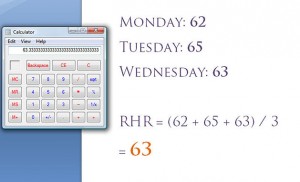 2) Find your maximum heart rate and heart rate reserve.
2) Find your maximum heart rate and heart rate reserve.
- Subtract your age from 220. This is your maximum heart rate (HRmax). For example, the HRmax for a 40-year-old would be220 – 40 = 180.
- Subtract your RHR from your HRmax. This is your heart rate reserve (HRmaxRESERVE). For example,HRmaxRESERVE = 180 – 63 = 117
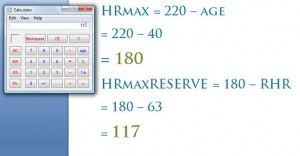 3) Calculate the lower limit of your THR. Figure 60% of the HRmaxRESERVE (multiply by 0.6) and add your RHR to the answer. For example,
3) Calculate the lower limit of your THR. Figure 60% of the HRmaxRESERVE (multiply by 0.6) and add your RHR to the answer. For example,
(117 * 0.6) + 63 = 133.
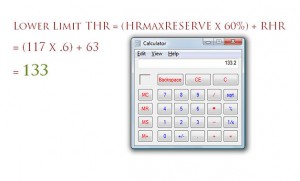 4) Calculate the upper limit of your THR. Figure 80% of the HRmaxRESERVE (multiply by 0.8) and add your RHR to the answer. For example,
4) Calculate the upper limit of your THR. Figure 80% of the HRmaxRESERVE (multiply by 0.8) and add your RHR to the answer. For example,
(117 * 0.8) + 63 = 157.
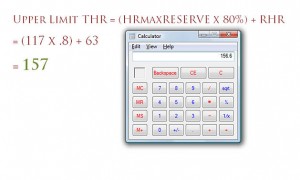 Combine the values obtained in steps 3 and 4 and divide by the number 2. This is your target heart rate (THR). For example,
Combine the values obtained in steps 3 and 4 and divide by the number 2. This is your target heart rate (THR). For example,
(133 + 157) / 2 = 145 (You can get the same result by simply multiplying HR max RESERVE by 0.70 and adding to it RHR).


